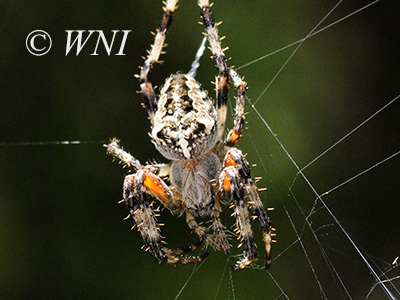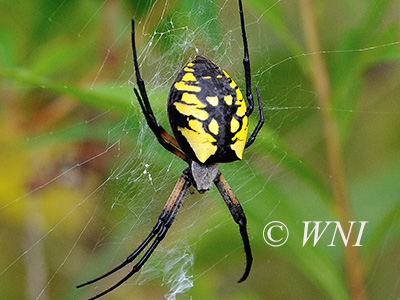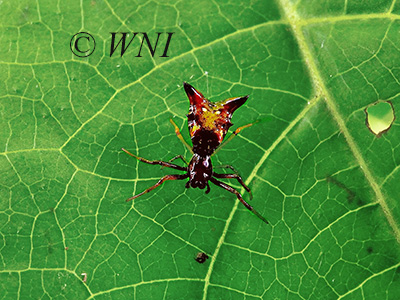| Orb Weavers (Araneidae) |
The Araneidae are the third-largest family of spiders (178 genera and ca. 3,500 species); cosmopolitan in distribution. They occur in nearly all habitats, natural or man-made. These are three-clawed spiders, with eight eyes in two rows; body length 6-50 mm. Sexually dimorphic, with females much larger than males. Legs hairy or spiny. Webs are flat, usually vertical, spiral circular or wheel-shaped; consist of a framework of non-sticky silk lines, joined together with a spiraling elastic thread covered in sticky droplets. The stabilimentum, a crisscross band of silk through the center of the web, is found in some genera. Few semi-social species live in communal webs. Several tropical genera (the bolas spiders) do not build webs, but suspend a sticky globule from a silk thread, catching moths attracted to a simulated pheromone emitted from the globule. Typically, females are found in the middle of their webs awaiting prey and mates; males, generally, do not spin webs. They die shortly after mating, e.g., frequently cannibalised by females. The Araneidae feed on insects trapped in their webs; some larger species occasionally catch and eat small birds, bats, or frogs. The prey is immobilized by a quick bite, wrapped in silk, and consumed, or saved for later.
 |
Nordmann's Orbweaver (Araneus nordmanni) |
|
 |
Yellow Garden Spider (Argiope aurantia) |
|
 |
Arrow-shaped Micrathena (Micrathena sagittata) |
|
| Unauthorized use of our images is NOT permitted. | ||
| Hotlinking or "pinning" of our images to websites is STRICTLY PROHIBITED. | ||
| Copyright © Michael Patrikeev - All Rights Reserved | ||
| |
||





